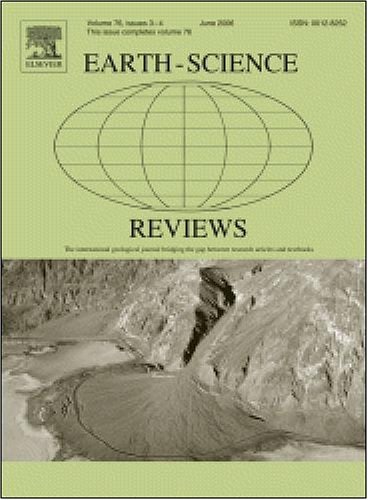古气候变化对中国淡水和咸水湖相油页岩有机质富集机制的影响:机器学习方法
IF 10.8
1区 地球科学
Q1 GEOSCIENCES, MULTIDISCIPLINARY
引用次数: 0
摘要
湖相油页岩是一种宝贵的非常规油气资源,其有机质富集与古气候条件密切相关。然而,在淡水和咸水湖泊环境中控制OM富集的机制仍未得到充分探讨。本研究首次应用随机森林(RF)分类器研究古气候变化对中国湖相油页岩OM富集机制的影响。通过对7个代表性湖相油页岩的总体地球化学(总有机碳、微量元素和主元素)和分子生物标志物数据的分析,表明射频分类器可以有效区分淡水和咸水湖相油页岩。结果表明,TOC含量是最重要的参数,淡水页岩的TOC值高于咸水页岩。进一步分析表明,古生产力、古水条件和陆源输入等因素共同驱动了这两种湖泊环境中有机质的富集,并受古气候变化的调节。淡水湖相页岩一般在湿润和温暖时期沉积,这一时期大气CO2水平较高,降水较多,导致古生产力提高,陆源流入减少,湖泊水位上升,有机质的产生和保存得到改善。咸化湖相页岩沉积在干冷期,水体盐度升高,古生产力降低,有机质产量降低,有机质保存减少,TOC含量降低。这些发现为了解古气候在形成富有机质湖相页岩中的作用提供了关键见解,并为评价富有机质页岩矿床建立了框架。该研究还强调了未来地球化学数据集在增强分类模型和扩大机器学习在油气资源勘探中的应用方面的潜力。本文章由计算机程序翻译,如有差异,请以英文原文为准。
Influences of paleoclimatic changes on organic matter enrichment mechanisms in freshwater and saline lacustrine oil shales in China: A machine learning approach
Lacustrine oil shales are valuable unconventional resources, with their organic matter (OM) enrichment closely linked to paleoclimatic conditions. However, the mechanisms controlling OM enrichment in freshwater and saline lacustrine environments remain underexplored. This study represents the first application of the random forest (RF) classifier to investigate how paleoclimatic changes influence OM enrichment mechanisms in lacustrine oil shales in China. By analyzing the bulk geochemical (total organic carbon (TOC), trace and major elements) and molecular biomarker data from seven representative lacustrine oil shales, we demonstrate that the RF classifier can effectively discriminate between freshwater and saline lacustrine oil shales. The results indicate that the TOC content is the most significant parameter, with freshwater shales having higher TOC values than their saline counterparts. Further analyses suggest that OM enrichment in these two types of lacustrine settings was driven by a combination of factors, including paleoproductivity, paleowater conditions, and terrigenous inputs, all modulated by paleoclimatic changes. Freshwater lacustrine shales were generally deposited during humid and warm periods with higher atmospheric CO2 levels and greater precipitation, which led to higher paleoproductivity, reduced terrigenous influx, rising lake levels, and improved OM production and preservation. In contrast, saline lacustrine shales were deposited during dry and cold periods, when increased water salinity and diminished paleoproductivity resulted in lower OM production, reduced preservation, and decreased TOC content. These findings provide key insights into the role of paleoclimate in shaping OM-rich lacustrine shales and establish a framework for evaluating organic-rich shale deposits. The study also underscores the potential for future geochemical datasets to enhance classification models and broaden applications of machine learning in the exploration of hydrocarbon resources.
求助全文
通过发布文献求助,成功后即可免费获取论文全文。
去求助
来源期刊

Earth-Science Reviews
地学-地球科学综合
CiteScore
21.70
自引率
5.80%
发文量
294
审稿时长
15.1 weeks
期刊介绍:
Covering a much wider field than the usual specialist journals, Earth Science Reviews publishes review articles dealing with all aspects of Earth Sciences, and is an important vehicle for allowing readers to see their particular interest related to the Earth Sciences as a whole.
 求助内容:
求助内容: 应助结果提醒方式:
应助结果提醒方式:


